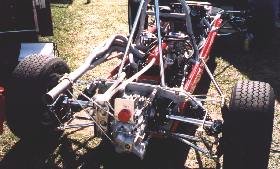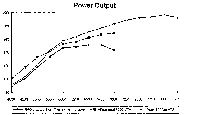Hartley H1 V8 for 300..500BHP
|
 |
|
|
|
Ford Crossflow (a.k.a. Kent) and Ford Zetec engine
comparison
|
Main Page
What's a Seven?
Driving
Build-page-story
Build-page-pics
Zetec vs. X-Flow
Conversion to Zetec
Gearbox upgrade
Maintenance Log
USA7-777
Gallery
Registration
Books
Links
e-Mail |
Popular engines for the Seven in
the US are the Ford Crossflow and
Zetec.
The Crossflow has a long and successful racing history.
In the
US it appeared modified (less efficient head design with recessed valves)
in the mundane Ford Pinto. Although an OHV pushrod design,
it's bowl-in-piston creates an inverted hemihead and makes tremendous
power
for a conventional engine, combined with intake and exhaust on either
side
of the head. This is implied for a DOHC, but at the time for an OHV
engine a
feature
worth mentioning.
valves)
in the mundane Ford Pinto. Although an OHV pushrod design,
it's bowl-in-piston creates an inverted hemihead and makes tremendous
power
for a conventional engine, combined with intake and exhaust on either
side
of the head. This is implied for a DOHC, but at the time for an OHV
engine a
feature
worth mentioning.
The preference for a tuned block is the later 711M
version
that
has remained in production by Samcor (South Africa) until
recently.
This has stronger webbing, wider cam follower tappets, 6 vs 4 bolt
flywheel and other
detailed
improvements over the older blocks.
170-200BHP racing engines have been produced revving up to 9,000 and
even 10,500. For the seven, more modest configurations are used and
135-150BHP
at 6500-7000rpm is a reasonable option from 1700cc. It is not well
known
in the US, but did establish itself as the basis for Formula Ford, with
1600cc /
100..110BHP regulation limited versions at 5500-6000rpm.
Some Ford Fiesta's used this engine as well, in case you're hunting for
one. The 711M is preferred over a Pinto derivative.
|
Here some plots showing some
significant Crossflow engine power outputs
from Kent Cam's VTA configurations:
 
On the counter side: The Ford Zetec is the main stream engine
of the '90's and is
found
in
the Contour, (Mondeo in Eu), Escort and Focus. It comes in various
displacements,
but the 2 ltr is popular in the US. The modern 16Valve DOHC forms
a good basis for tuning. Large production volumes ensure good
availability
and low parts cost. In the US a low-mileage long block can be obtained
for $700-1000. It is very tuneable and has been pushed over 100BHP/ltr
with natural aspiration. At 6500rpm, it's capable of 160-175BHP. An
aluminum
version is supposedly in production now, promising improved thermal
behavior
and lower weight.
The first 4 Zetec pictures are courtesy of Steve K's engine
collection
for his Birkin - thanks Steve. Pictures of the Crossflow are from my
car,
while I converted it from the 1600 /110BHP to the 1700 /150BHP
spec
. This is the 1700cc version with various performance mods.
The earlier Zetec's have heavy cranks with modest balancing. The newer
'02 ZX engines have slightly lighter cranks, but much better balancing
and more important better guidance for the cam chain and the backwards
running waterpump issue is also resolved in the newer engines. These
can be recognized by the black ABS valve cover, vs the cast Alu one of
the older ones. Note that few parts (e.g. heads) do not interchange (!) between
the older and newer Zetec's - heads / cam drive / waterpump and various
bolt holes are all different.
The bottom
Zetec head-picture is from the ZX3 Focus version from my car. In May of
2002 I switched out the Crossflow for a ZX3
Focus-Zetec - see
Crossflow to Zetec page
|
Some notions on combustion chambers:
The Xflow uses the "Heron" or "bowl-in-piston"
chamber which allows for good manipulation of the chamber profile. In
some
versions the 1300cc pistons are used as they have a "pure" bowl,
without
valve cut-outs. For high lift cams, valve cutouts are needed to avoid
valve/piston
contact at high rpms.
A critical element of good Xflowing is the flow around the valves.
The flat head helps, although the 90 degree entry and exit angles are a
disadvantage
compared
to a pentroof design. Valve shrouding is less of an issue provided
there
is space between the wall. The Pinto Xflow head has a disadvantage as
the
valves are slightly recessed in the head, reducing peak flow.
With a DOHC design the valve timing profiles can be sharper (faster
open / close times), so that the opening x time area is favorable
compared
to conventional pushrod implementations. Key is reduction of
reciprocating
valve train mass. Lighter valves can be accelerated faster and thus
open
and close faster. Reciprocating mass, the cam follower, pushrod,
rocker, valve
spring disc, top half of the springs, valve all contribute to the total
mass, compared to
tappet, top half of spring, valve in the DOHC. The XF Pushrod's other
advantage is
lower engine height - a major parameter for a fit in a Seven.
For high rpm tuning (beyond 6000rpm) the DOHC is the right choice.
But,
not without proper gas flow control. Managing flow inclusive from air
filter
upto the chamber and out of the exhaust manifold into the headers and
muffler
all determine how much gas can be flowed through the engine and
determine
VE or Volumetric efficiency or it's torque capacity.
Porting is important - the shape or flow of the intake tract is
critical,
with a minimal diameter variations other than a gradual tapering from
carb
venturi or throttle body to the intake valve. This will maximize the
mixture
velocity into the chamber. Avoiding turbulence in the intake tract,
maintains
maximum flow capacityl. Only rough polishing is recommended. A very
smooth
finish is not desirable. The rough surface supposedly helps to breakup
smaller droplets.
Another consideration are the pistons themselves. A major drawback
of
the Heron chamber is that the top compression ring sits low and also,
it
makes for a heavy piston, limiting max rpm. The low sitting compression
ring increases the crevice space between the piston crown and the walls
above the first ring. It's a small space, but at max compression it
contains
considerable mixture, which will be late to combust if at all. For top
tuning, the ring needs to move up. A good chamber however tapers at the
edge allowing for squishing of the mixture, increasing it's speed
during
combustion. See here an 81mm bore piston
from the 1600 XF , but the same principle applies in other Crossflows
with
larger bores.
A good indicator of a fast burning chamber configuration is the
amount of ignition
advance
needed. Extended flame propagation time also means that some of
the mixture will burn while the piston is well down, meaning more
energy lost through the exhaust.


 valves)
in the mundane Ford Pinto. Although an OHV pushrod design,
it's bowl-in-piston creates an inverted hemihead and makes tremendous
power
for a conventional engine, combined with intake and exhaust on either
side
of the head. This is implied for a DOHC, but at the time for an OHV
engine a
feature
worth mentioning.
valves)
in the mundane Ford Pinto. Although an OHV pushrod design,
it's bowl-in-piston creates an inverted hemihead and makes tremendous
power
for a conventional engine, combined with intake and exhaust on either
side
of the head. This is implied for a DOHC, but at the time for an OHV
engine a
feature
worth mentioning. 











